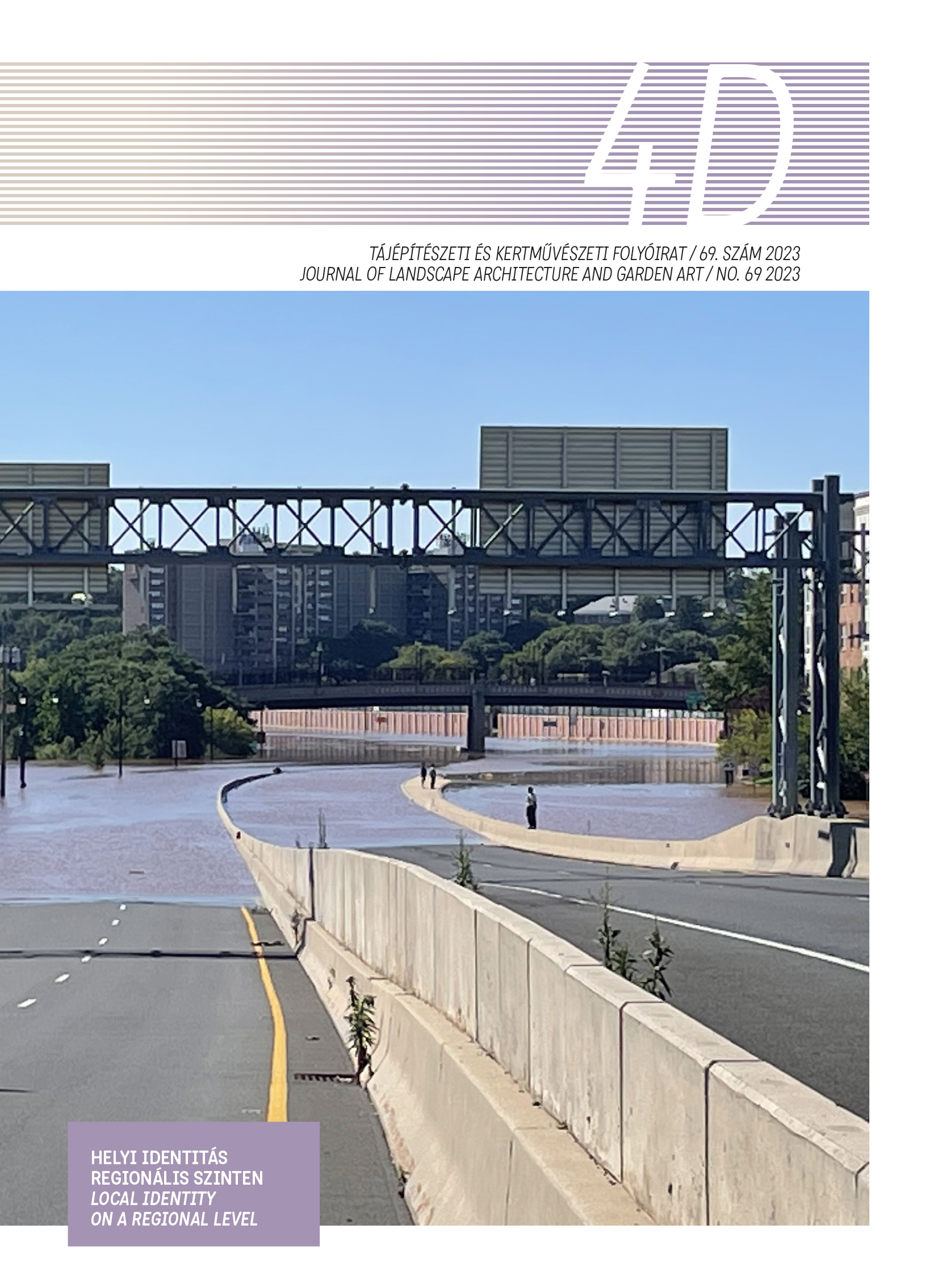Story of a Master Project: the planning process of the herb garden in Szentendre
DOI:
https://doi.org/10.36249/4d.69.4496Keywords:
master project, herb garden, landscape protection, landscape integration, grasslandAbstract
Senior students of the Landscape Architecture Masters
programme writing their thesis at the Department of Landscape Protection and Reclamation (hereinafter: Department) conclude their education by participating in a so-called “Master Project”. The method of Master
Projects is team supervision, the supervisors being lecturers of associated courses – Thesis Project 2, Landscape Restoration, Fitting into the Landscape – and other lecturers invited based on the topic. The plan, finished in a total of eight weeks (two weeks of workshops and six weeks of study period) is typically programme-level. Creating a concept is a collaborative task, but students also make individual designs for sub-tasks. Some important characteristics of Master Projects are that they are realistic, involving real clients and contributing professionals, provide real planning tasks, and include participator elements and communication with local communities. In the autumn of 2022, the town of Szentendre reached out to the Department with a design topic that was highly compatible with Master Projects, the development of the area next to Kőhegyi Road (lot number 0181/6), in a different way from current zoning regulations. The location of the area on the settlement fringe, its zoning situation, the surrounding natural values as well as its partial designation as an ecological corridor all required careful preparation and a landscape-conservation-based approach. After preparing a site analysis, senior students writing their theses on the Department were included in the planning process. Based on the analyses and considering local restrictions and opportunities, the students designed a complex development – a half-hectare, closed herb garden and several freely accessible recreational facilities in the entry area connecting the garden with the town and transport routes. The proposal also decreases pressure on areas with high nature conservation value, with the management tasks of these valuable habitats also being appointed to the operator of the garden. Case studies provided an excellent basis for the concept of the herb garden, and based on experience, a design proposal was created that is sustainable, fits into its surroundings both visually and ecologically and fulfils economic and visitor requirements alike.
References
AGROTOPO, agrotopográfiai adatbázis URL:http://www.elkh-taki.hu/hu/osztalyok/kornyezetinformatikai-osztaly/agrotopo (letöltés: 2022.05.25.)
Borhidi Attila (1995): Social behaviour types, the naturalness and relative ecological indicator values of the higher plants in the Hungarian Flora. Acta. Bot. Hung. 39 (1-2): 97-181.
Boromisza Zsombor – Hubayné Horváth Nóra – Módosné Bugyi Ildikó – Erdei Tímea – Gergely Attila – Koch Dóra – Lugosi Flóra – Nádasy László – Sándor Gábor (2019): Ökoturisztikai létesítmények tájbaillesztése – tervezési segédlet. Megbízó: Duna-Ipoly Nemzeti Park Igazgatóság. Ormos Imre Alapítvány, Budapest.
Bölöni János – Molnár Zsolt – Horváth Ferenc – Illyés Eszter (2008): Naturalness-based habitat quality of the Hungarian (semi-)natural habitats. Acta Botanica Hungarica. 50 (Suppl.): 149-160. DOI: https://doi.org/10.1556/ABot.50.2008.Suppl.7
Bölöni János – Molnár Zsolt – Kun András (szerk.) (2011): Magyarország élőhelyei. Vegetációtípusok leírása és határozója. ÁNÉR 2011. MTA Ökológiai és Botanikai Kutatóintézete: Vácrátót.
Dövényi Zoltán (szerk.) (2010): Magyarország kistájainak katasztere. MTA Földrajztudományi Kutatóintézet: Budapest.
Gergely Attila (2022): Szentendre hrsz. 081/6. Botanikai állapotfelmérés. (Botanical studies). MATE Tájvédelmi és Tájrehabilitációs Tanszék, Budapest (mscr.)
Halimba Szalai Miklós Gyógynövényeskert Bemutató és Oktatóközpont Kertépítészeti terv. 2007. Pagony Táj-és Kertépítész Iroda, dr Herczeg Ágnes, okl. táj- és kertépítész, K1 01-5025/04, Deák Adrienn Ágnes, okl. táj- és kertépítész, dr Székely Gabriella, okl. kertészmérnök, Tóth Péter, építész.
Király Gergely – Molnár Zsolt – Bölöni János – Csiky János – Vojtkó András (szerk.) (2008): Magyarország földrajzi kistájainak növényzete. MTA ÖBKI: Vácrátót.
MATE Tájvédelmi és Tájrehabilitációs Tanszék (2022): Gyógynövénykertek és fűszerkertek, hazai példák, jó gyakorlatok. Tanulmány.
MSZ 20378:2018 Tájvédelem. A tájba illesztést igazoló dokumentáció műszaki követelményei. Magyar szabvány. (Landscape protection. Technical requirements of the documentation to fitting into the landscape)
Sipos Laura (2021): Botanikus kertek kialakulása, tervezése, építése, és használatuk a gyógyításban. Művelődés-, Tudomány- és Orvostörténeti Folyóirat. 2021. Vol. 11. No. 22. pp. 420-464. DOI: https://doi.org/10.17107/KH.2021.22.420-464
Szentendre Építési Szabályzata (SZÉSZ) és Szabályozási Terve (SZT) – hatályos, elfogadva a 26/2017. (VII.31.) önkormányzati rendelettel
Szentendrei Ökológiai és Gyógynövény Élménykert, Koncepcióterv. 2022. MATE Tájvédelmi és Tájrehabilitációs Tanszék és a Msc II. évfolyam (Gyöngyösi Eszter – Gyöngyösi Kevin – Hetényi Renáta – Lach Bálint – Selymes Sára Ajnácska – Szűcs-Józsa Sára) Magyar Agrár- és Élettudományi Egyetem, Tájépítészeti, Településtervezési és Díszkertészeti Intézet, Budapest.
Szóbeli adatközlők
● Boldizsár-Mátyás Gabriella, Györgytea Kft. Bükszentkereszti Gyógynövénykert, (2022. szept. 27.)
● Kovácsné Wéber Eszter, Szalai Miklós Gyógynövényeskert Bemutató és Oktatóközpont, Halimba (2022. május 20.)
● Kaszián Ágota, Balatonfelvidéki Nemzeti Park, Salföldi major, Salföld (2022.május 19.)
● Takács Tamás, Gyógynövény-völgy Látogató- és Oktatóközpont, Zánka (2022. május 5.)
Downloads
Published
Issue
Section
License
Copyright (c) 2023 Illyés Zsuzsanna, Gergely Attila, Hubayné Horváth Nóra, Módosné Bugyi Ildikó, Nádasy László Zoltán, Földi Zsófia, Valánszki István

This work is licensed under a Creative Commons Attribution-NonCommercial-NoDerivatives 4.0 International License.
A folyóirat Open Access (Gold). Cikkeire a Creative Commons 4.0 standard licenc alábbi típusa vonatkozik: CC-BY-NC-ND-4.0. Ennek értelmében a mű szabadon másolható, terjeszthető, bemutatható és előadható, azonban nem használható fel kereskedelmi célokra (NC), továbbá nem módosítható és nem készíthető belőle átdolgozás, származékos mű (ND). A licenc alapján a szerző vagy a jogosult által meghatározott módon fel kell tüntetni a szerző nevét és a szerzői mű címét (BY).



